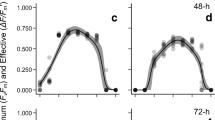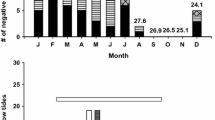Abstract
In coastal waters and estuaries, seagrass meadows are often subject to light deprivation over short time scales (days to weeks) in response to increased turbidity from anthropogenic disturbances. Seagrasses may exhibit negative physiological responses to light deprivation and suffer stress, or tolerate such stresses through photo-adaptation of physiological processes allowing more efficient use of low light. Pulse Amplitude Modulated (PAM) fluorometery has been used to rapidly assess changes in photosynthetic responses along in situ gradients in light. In this study, however, light is experimentally manipulated in the field to examine the photosynthesis of Halophila ovalis and Zostera capricorni. We aimed to evaluate the tolerance of these seagrasses to short-term light reductions. The seagrasses were subject to four light treatments, 0, 5, 60, and 90% shading, for a period of 14 days. In both species, as shading increased the photosynthetic variables significantly (P < 0.05) decreased by up to 40% for maximum electron transport rates (ETRmax) and 70% for saturating irradiances (Ek). Photosynthetic efficiencies (α) and effective quantum yields (ΔF/Fm′) increased significantly (P < 0.05), in both species, for 90% shaded plants compared with 0% shaded plants. H. ovalis was more sensitive to 90% shading than Z. capricorni, showing greater reductions in ETRmax, indicative of a reduced photosynthetic capacity. An increase in Ek, Fm′ and ΔF/Fm′ for H. ovalis and Z. capricorni under 90% shading suggested an increase in photochemical efficiency and a more efficient use of low-photon flux, consistent with photo-acclimation to shading. Similar responses were found along a depth gradient from 0 to10 m, where depth related changes in ETRmax and Ek in H. ovalis implied a strong difference of irradiance history between depths of 0 and 5–10 m. The results suggest that H. ovalis is more vulnerable to light deprivation than Z. capricorni and that H. ovalis, at depths of 5–10 m, would be more vulnerable to light deprivation than intertidal populations. Both species showed a strong degree of photo-adaptation to light manipulation that may enable them to tolerate and adapt to short-term reductions in light. These consistent responses to changes in light suggest that photosynthetic variables can be used to rapidly assess the status of seagrasses when subjected to sudden and prolonged periods of reduced light.



Similar content being viewed by others
References
Abal EG, Loneragan NR, Bowen P, Perry CJ, Udy JW, Dennison WC (1994) Physiological and morphological responses of the seagrass Zostera capricorni Aschers. to light intensity. J Exp Mar Biol Ecol 178:113–129
Alcoverro T, Cerbian E, Ballesteros E (2001) The photosynthetic capacity of the seagrass Posidonia oceanica: influence of nitrogen and light. J Exp Mar Biol Ecol 261:107–120
Beer S, Vilenkin B, Weil A, Veste M, Susel L, Eshel A (1998) Measuring photosynthetic rates in seagrasses by pulse amplitude modulated (PAM) fluorometry. Mar Ecol Prog Ser 174:293–300
Biber PD, Paerl HW, Gallegos CL, Kenworthy WJ (2005) Evaluating indicators of seagrass stress to light. In: Bortone SA (ed) Estuarine indicators. CRC, Boca Raton, FL, pp 193–210
Campbell SJ, McKenzie LJ (2004) Flood related loss and recovery of intertidal seagrass meadows in southern Queensland, Australia. Estuarine Coast Shelf Sci 60:477–490
Campbell SJ, Miller C, Steven A, Stephens A (2003) Photosynthetic responses of two temperate seagrasses across a water quality gradient using chlorophyll flourescence. J Exp Mar Biol Ecol 291:57–78
Czerny AB, Dunton KH (1995) The effects of in situ light reduction on the growth of two subtropical seagrasses, Thalassia testudinum and Halodule wrightii. Estuarties 18:418–427
Dennison WC (1987) Effects of light on seagrass photosynthesis, growth and depth distribution. Aquat Bot 27:15–26
Dennison WC, Alberte RS (1986) Photoadaptation and growth of Zostera marina L. (eelgrass) transplants along a depth gradient. J Exp Mar Biol Ecol 98:265–383
Duarte CM (1991) Seagrass depth limits. Aquat Bot 40:363–377
Durako MJ, Kunzelman JI, Kenworthy J, Hammerstrom KK (2003) Depth-related variability in the photobiology of two populations of Halophila johnsonii and Halophila decipiens. Mar Biol 142:1219–1228
Enríquez S, Merino M, Iglesias-Prieto R (2002) Variations in the photosynthetic performance along the leaves of the tropical seagrass Thalassia testudinum. Mar Biol 140:891–900
Gallegos CL, Kenworthy WJ (1996) Seagrass Depth limits in the Indian River Lagoon (Florida, USA): application of an optical water quality model. Estuarine, Coast Shelf Sci 42:267–288
Ibarra-Obando SE, Heck KL, Spitzer PM (2004) Effects of simultaneous changes in light, nutrients, and herbivory levels, on the structure and function of a subtropical turtlegrass meadow. J Exp Mar Biol Ecol 301:193–224
Jassby AT, Platt T (1976) Mathematical formulation of the relationship between photosynthesis and light for phytoplankton. Oceanography 21:540–547
Kraemer GP, Alberte RS (1995) Impact of daily photosynthetic period on protein synthesis and carbohydrate stores in Zostera marina L. (eelgrass) roots: implications for survival in light-limited environments. J Exp Mar Biol Ecol 185:191–202
Kraemer GP, Hanisak MD (2000) Physiological and growth responses of Thalassia testudinum to environmentally-relevant periods of low irradiance. Aquat Bot 67:287–300
Lan C-Y, Kao W-Y, Lin H-J, Shao K-T (2005) Measurement of chlorophyll fluorescence reveals mechanisms for habitat niche separation of the intertidal seagrasses Thalassia hemprichii and Halodule uninervis. Mar Biol 148:25–34
Longstaff BJ, Dennison WC (1999) Seagrass survival during pulsed turbidity events: the effects of light deprivation on the seagrasses Halodule pinifolia and Halophila ovalis. Aquat Bot 65:105–121
Longstaff BJ, Loneragan NR, O’Donohue MJ, Dennison WC (1999) Effects of light deprivation on the survival and recovery of the seagrass Halophila ovalis (R.Br.) Hook. J Exp Mar Biol Ecol 234:1–27
Peralta G, Pérez-Lloréns JL, Hernández I, Vergara JJ (2002) Effects of light availability on growth, architecture and nutrient content of the seagrass Zostera noltii Hornem. J Exp Mar Biol Ecol 269:9–26
Preen AR, Long WJL, Coles RG (1995) Flood and cyclone related loss, and partial recovery, of more than 1000 km2 of seagrass in Hervey Bay, Queensland, Australia. Aquat Bot 52:3–17
Ralph PJ (1996) Diurnal photosynthetic patterns of Halophila ovalis (R.Br.) Hook f. In: Kuo J, Phillips RC, Walker DI, Kirkman H (eds) Seagrass biology: proceedings of an international workshop, Rottnest Island, Western Australia, pp 197–202
Ralph PJ, Gademann R (2005) Rapid light curves: a powerful tool to assess photosynthetic activity. Aquat Bot 82:222–237
Ralph PJ, Gademann R, Dennison WC (1998) In situ seagrass photosynthesis measured using a submersible, pulse-amplitude modulated fluorometer. Mar Biol 132:367–373
Ruiz JM, Romero J (2001) Effects of in situ experimental shading on the Mediterranean seagrass Posidonia oceanica. Mar Ecol Prog Ser 215:107–120
Schreibers U, Hormann H, Neubauer C, Klughammer C (1995) Assessment of photosystem II photochemical quantum yield by chlorophyll fluoroscence quenching analysis. Aust J Plant Physiol 22:209–220
Schwarz A-M, Hellblom F (2002) The photosynthetic light response of Halophila stipulacea growing along a depth gradient in the Gulf of Aqaba, the Red Sea. Aquat Bot 74:263–272
Silva J, Santos R (2003) Daily variation patterns in seagrass photosynthesis along a vertical gradient. Mar Ecol Prog Ser 257:37–44
Acknowledgements
This work was conducted as part of a Ph.D. degree in the School of Tropical Environment Studies and Geography, James Cook University. The work was supported by an Australian Postgraduate Award (Industry) from the Australian Research Council and Industry partners, Queensland Department of Primary Industries and Fisheries, Queensland, Parks and Wildlife Service (Environment Protection Authority) and World Wide Fund for Nature (WWF). The appropriate permit, required to remove seagrasses in Queensland, was obtained from the Queensland Department of Industries and Fisheries. The authors would like to acknowledge S. Kerville and D. Foster for their technical and field assistance.
Author information
Authors and Affiliations
Corresponding author
Additional information
Communicated by G.F. Humphrey.
Rights and permissions
About this article
Cite this article
Bité, J.S., Campbell, S.J., McKenzie, L.J. et al. Chlorophyll fluorescence measures of seagrasses Halophila ovalis and Zostera capricorni reveal differences in response to experimental shading. Mar Biol 152, 405–414 (2007). https://doi.org/10.1007/s00227-007-0700-6
Received:
Accepted:
Published:
Issue Date:
DOI: https://doi.org/10.1007/s00227-007-0700-6




